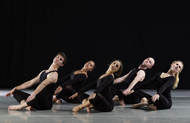History of Graham Technique
By Move Dance on 28th Jun 2023
If you have ever done a contemporary dance class then you are likely to have practised Graham Technique. Graham Technique interprets movements based on the Martha Grahams personal life experiences. Helping dancers control their movements gracefully and freely. Let's take a look at her life to see how she developed one of the most recognisable, stylised and unique dance techniques.
Early life
Martha Graham was born in Pennsylvania in 1894. At age 21, she moved to New York City to pursue her passion for dance. In the mid-1910s, Martha Graham began her studies at Denishawn School of Dancing and Related Arts. Once she left her training Martha was determined to create a dance style that stripped away the elaborate movements of ballet and focus more on the foundational aspects of movement. In 1925, Graham was employed at the Eastman School of Music, the next year she then established the Martha Graham Center of Contemporary Dance, in a small studio on the Upper East Side of New York City. Here is where she developed the technique focusing on emotion rather than technical perfection.
Contract and release
If you have ever done a Graham class you will know your abdominals are in bits the next day! This will be from the release and contract technique, which dancers still practice today. This technique relies heavily on deep breathing, with specific movements beginning with a contraction of the dancer's muscles and ending with a release or extension.
Use of space and gravity
In a Graham class you will probably spend a lot of time on the floor. Graham used lots of deep plies and swinging movements to explore the relationship between the dancer and the floor, air, and other dancers. This revolutionised how dancers interact with space around them and interpret gravity.
Breath
The power of breath has been used to enhance a dancer's performance for a long time. Dancers using Martha Graham's dance technique understood the importance of using their breath to ensure harmony between body and mind when executing a complex move. Focused breathing during the Graham movement helps dancers deepen their connection with each other and the music, making the dancer's performance more powerful and emotive. It is the same for any physical movement without good breathing techniques you can quickly tire and lose focus.
Legacy
Martha Graham is one of the most influential dance practitioners in modern dance, Graham technique has not only influenced dancers across all forms of dance genres such as contemporary choreographers and Hollywood dancers such as Gene Kelly and Bob Fosse.
The success of this technique is due to her high expectations and passion for perfecting movement through self-expression. Graham updated classical techniques while creating something entirely new.
Martha Graham's technique of modern dance has withstood the test of time, remaining influential in 21st-century dancer's movements across stages and studios worldwide. And it will surely live on for centuries to come.
Written with reference to:
https://londondance.photography/blog/what-is-martha-graham-technique
Want to learn more about the dance industry and its history? Check out our History of Ballet and Celebrating International Dance Day Through The History of Dance blogs!
If you need to stock up on our dancewear for your contemporary classes or need a costume for your contemporary dance check out our wide range of dance leotards, dance shoes and dance costumes!
Move Dance Team x
19/06/23
